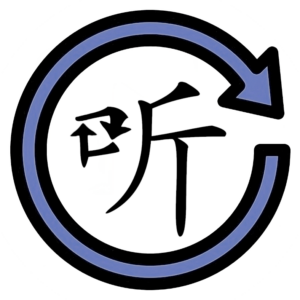 Listening more than once is a simple yet overlooked trick for improving your listening ability in Chinese. By replaying audio, you give your brain more time to process the language, and as a result, you will understand and learn more.
Listening more than once is a simple yet overlooked trick for improving your listening ability in Chinese. By replaying audio, you give your brain more time to process the language, and as a result, you will understand and learn more.
Understanding spoken Chinese is more complex than most people realise, and listening to the same audio more than once is helpful in many ways. For example, it lowers the difficulty and increases the range of listening material you can access. It also allows you to review and consolidate what you already know while freeing up your mental capacity to deal with new things.
Tune in to the Hacking Chinese Podcast to listen to the related episode:
Available on Apple Podcasts, Google Podcast, Overcast, Spotify, YouTube and many other platforms!
Listening comprehension in Chinese is a complex task
Listening comprehension in a foreign language is a complex process. We often underestimate the complexity because of how automatic listening comprehension is in our native language, but when we start learning Chinese, we quickly realise how hard it can be. In fact, listening in Chinese is uniquely difficult in several ways.
We need to do two kinds of processing at once:
 Bottom-up processing is about extracting information from the spoken language. It’s about converting sound waves to speech sounds, segmenting connected speech into words and associating them to meaning, and then combining words into phrases and sentences that mean something. Bottom-up processing is like using bricks to build a house. While bottom-up processing is essential for listening comprehension, it would be wrong to think that all the information you need to understand can be extracted from the Chinese you listen to. We also need top-down processing.
Bottom-up processing is about extracting information from the spoken language. It’s about converting sound waves to speech sounds, segmenting connected speech into words and associating them to meaning, and then combining words into phrases and sentences that mean something. Bottom-up processing is like using bricks to build a house. While bottom-up processing is essential for listening comprehension, it would be wrong to think that all the information you need to understand can be extracted from the Chinese you listen to. We also need top-down processing. Top-down processing is about using information not present in the utterance itself (i.e. prior knowledge) to make sense of what we hear and interpret it. It’s a bit like looking at the blueprint of a house to figure out where a certain brick or piece ought to go or know enough about architecture to realise that there should be a corridor here and a load-bearing wall there, or notice that something is wrong when a room has no doors. Top-down processing supports bottom-down processing by limiting the number of possible options, creating hypotheses and testing them.
Top-down processing is about using information not present in the utterance itself (i.e. prior knowledge) to make sense of what we hear and interpret it. It’s a bit like looking at the blueprint of a house to figure out where a certain brick or piece ought to go or know enough about architecture to realise that there should be a corridor here and a load-bearing wall there, or notice that something is wrong when a room has no doors. Top-down processing supports bottom-down processing by limiting the number of possible options, creating hypotheses and testing them.
You can read more about these processes by clicking the links above, but here, it’s enough to know that there are so many things to deal with at once that it quickly becomes overwhelming. Through practice, we can automate much of this processing, which frees up mental resources to deal with the things we haven’t automated yet, something I covered in the article Beyond tīng bu dǒng, part 4: Learning to process spoken Mandarin quickly and effortlessly.
Beyond tīng bu dǒng, part 4: Learning to process spoken Mandarin quickly and effortlessly
Listening to something in Chinese for the first time
Listening to audio in Chinese is often unnecessarily difficult. The top-down processing mentioned above requires a decent understanding of context; otherwise, you don’t know what to expect and can’t rely on prior knowledge. Many listening practice activities have you listen to audio snippets without knowing who’s talking, where they are and what you, as a listener, are doing there. All these things are apparent when listening to Chinese in real life.
As a student, you can only do so much to remedy this problem. You can choose listening material that does offer more context, such as video content, but there is an easier way: Listen again!
Listening in Chinese is considerably harder the first time you listen than the second time, even if you hit the replay button immediately without looking anything up or changing anything else in the listening situation. The difference can sometimes be large, and while it’s hard to quantify, it’s not unusual to go from “only understanding some words here and there” to “getting the gist of what was said” just by listening one more time.
Listening to the same passage a second time is easier
This works because when you listen the second time, you can use what you learnt the first time to figure out things about the context. This allows you to rely more on top-down processing, which will also help your bottom-up processing, leading to a better understanding. This happens automatically, but you can enhance the effect by reflecting on your understanding before hitting the replay button.
For example, if it’s a conversation, you know who’s in it and the structure of the conversation. If you understand something that happens later in the conversation, this will aid your understanding of the beginning of the conversation the second time you listen. If you’re listening to audio with images, such as when watching a movie, understanding the plot and what will happen later greatly increases your chances of understanding what people are saying.
When you know some things in advance, you can also use your limited capacity for controlled processing to focus on new things. This helps! In the article about controlled and automated processing, I used the analogy of a spotlight (controlled processing ) and a floodlight (automated processing). If listening is a fast-paced action sequence in a dense jungle, you will only be able to identify a small sliver of the whole picture with your spotlight, but if you’re allowed to replay the scene many times, you can gradually use the spotlight to illuminate previously dark areas.
Finally, when listening a second time, you will be more familiar with people’s voices and accents than you were the first time.
To summarise, listening again is likely to help your understanding significantly. This is important because a good rule of thumb is that the more you understand, the better. When exploring new sources of Chinese listening practice, try listening again before discarding something as being too hard! This advice applies both to beginners and advanced students. As an advanced student, I sometimes listen to an audiobook and think it’s too hard, but after listening to the first chapter twice, the rest of the book becomes more accessible!
Listening to the same passage more than twice is also helpful
The benefits of listening more than once can be extended beyond listening twice, but only up to a point. You will likely see the most significant jump in comprehension between the first and second time, but if you haven’t already spent a lot of time building a solid listening ability in Chinese, you’ll still see substantial benefits after the third, fourth or fifth time, too. If the passage is long and relatively complex, you might be able to listen a hundred times and still increase comprehension each time!
Naturally, there’s a limit to how much it makes sense to listen to the same passage, if nothing else, because it gets boring after a while. It’s interesting to note, however, that children, when learning their first language, like listening or watching the same things repeatedly. I can still recite verbatim some of the audio narrations and films I liked watching thirty years ago. I don’t know if there’s any research into how this affects language learning, but it would be strange if it didn’t have any impact.
Another thing to consider is the opportunity cost. Listening to the same podcast episode the tenth time should be weighed against listening to something new. In general, this boils down to how easy access you have to listening material at your proficiency level. As a beginner, you’re unlikely to be able to listen to things once and understand enough to move on without any further time investment, but as an advanced student, it’s usually better to become exposed to a broader range of Chinese by simply listening to something new.
Listening many times as a way of reviewing vocabulary and grammar
Listening many times allows you to review the vocabulary and grammar contained in the audio. The spacing effect and spaced repetition also apply here, so if you want to review and consolidate what you already know, you should listen again but spread it out over time. What I have discussed so far is mostly to hit replay immediately after listening to a passage, but now we’re talking about re-listening tomorrow, next week or next month.
This requires you to build a personal Chinese audio library, something I will cover in an upcoming article. Saving audio you listen to so you can access it again easily ensures you always have something to listen to, no matter where you are and what situation you’re in. A key component of your Chinese audio library is familiar audio you have already listened to and/or studied.
Listening more than once as a method to decrease difficulty
As mentioned, one of the biggest benefits of listening more than once is that it significantly reduces difficulty. You will be able to deal with much harder listening content if you allow yourself to listen several times, compared with if you only listen once.
It’s not easy to pinpoint an exact percentage for how much you should understand in a passage for it to be optimal for improving listening ability, but it’s likely to be well above 90%, probably closer to 100% (see this article about the related concept of extensive reading).
Now, as a beginner, this is almost impossible to achieve. Even if you use audio from your textbook that relies only on words and grammar you have studied, you will not come close even to 90% comprehension.
Unless you listen more than once, that is. By listening more than once, you can gradually figure out what some things mean, guess what others mean, and identify which keywords you don’t understand and probably won’t understand, regardless of how many times you listen.
For more suggestions on how to get around this problem as a beginner, please refer to Beginner Chinese listening practice: What to listen to and how.
Beginner Chinese listening practice: What to listen to and how
The grand listening cycle
Now that we have covered the most important reasons why listening more than once is so helpful, let’s look at how it can help you approach very difficult listening material. Usually, I don’t think it’s a good idea to make listening and reading difficult by choice, but sometimes you need or want to listen to something difficult. For more about the relationship between difficulty and how much you learn, please check this article: Can you learn Chinese faster by making it harder?
I’ve written I guide for how I approach difficult listening material. You don’t need to stick to this precisely, so remix the method according to your preferences and needs, but here’s a procedure you can apply to your listening practice right now:
- Benchmarking – Find something you think you should be able to make sense of, then listen to it once and estimate how much you understood. This works better if you take the first part of a longer passage. You can then work your way through the entire passage. Try to choose audio with a transcript, but don’t look at it yet.
- Listening more than once – Listen to the audio over and over until you feel that each listen doesn’t teach you anything or you feel you’ve started to lose interest. I find this rather enjoyable, but if you don’t, stop before it becomes too boring.
- Transcribing – Go through the audio slowly, allowing yourself to pause whenever you want, and try to write down what’s being said. This is rather time-consuming, but it encourages you to commit your understanding to writing. If you don’t know, guess and mark the guess in a different colour.
- Studying – Go through the audio with the transcript, fill in the blanks and verify that you heard the words correctly. Correct any mistakes. If there were any new words or sentence patterns you weren’t familiar with, consider learning them if they are important (but don’t learn them just because you can; this will lead to vocabulary overload quickly).
- Reviewing – Save the audio in your personal Chinese audio library. This allows you to review the audio later. You can also add words and sentences to the flashcard program of your choice if you want.
You can continue doing this with each shorter snippet in a longer passage or choose a different piece of content to work with! As I said, you don’t need to follow the process exactly as written above, but listening many times and allowing your brain to adjust to the Chinese gradually is excellent, both for bringing comprehension about and for improving your Chinese listening ability!
